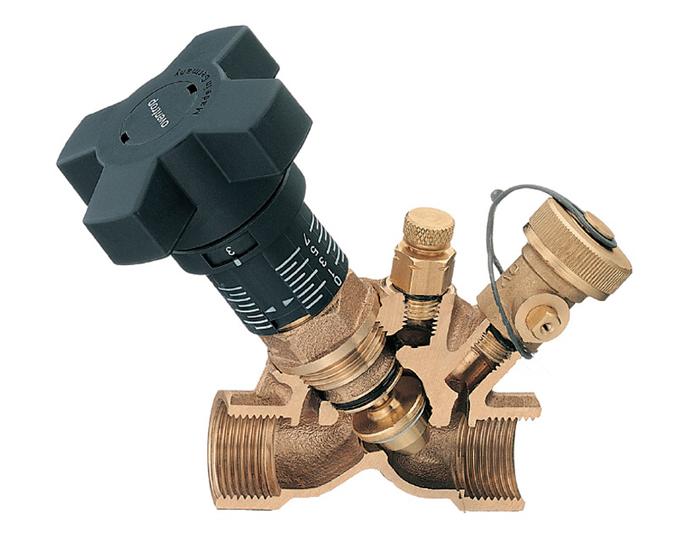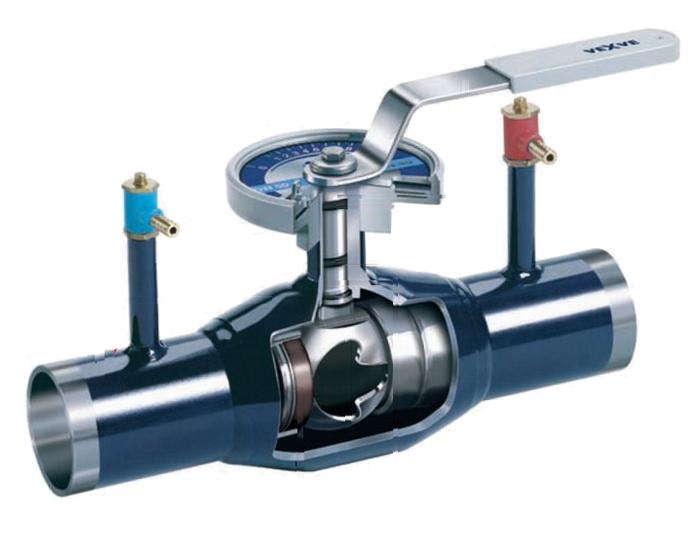Bitte blockieren Sie keine Werbung auf unserer Website. Klicks auf Anzeigen helfen uns, zu existieren, zu wachsen und für Sie nützlicher zu werden!
Konstruktion des Regelventils
Manuelle Abgleichventile werden auf der Grundlage eines Sitzventils oder eines Kugelhahns hergestellt. Im Vergleich zu Absperrarmaturen arbeiten Regelarmaturen unter härteren Bedingungen mit möglicher Kavitation, hohen Druckunterschieden und hohen Strömungsgeschwindigkeiten des Arbeitsmediums. Die Konstruktion von Abgleichventilen ist zuverlässiger als die von Absperrarmaturen und für die Regelung ausgelegt.
Für eine bequeme Einstellung kann ein Abgleichventil folgende Vorrichtungen haben:
- Feststeller der eingestellten Position
- Positionsanzeige des Verschlusses und Einstellwert
- Stutzen zum Entleeren des Abschnitts, an dem das Ventil montiert ist
- Messblende zur genauen Bestimmung des Durchflusses
- Stutzen zur Messung von Durchfluss, Druck und Druckunterschied am Ventil
- Möglichkeit der Absperrfunktion bei Beibehaltung des Einstellwerts
Sitzabgleichventil: Das Regelorgan bei diesen Ventilen ist ein Sitzverschluss. Das Abgleichventil besteht aus einem Gehäuse mit einer festen Überwurfmutter, einem drehbar auf eine Gewindestange montierten Verschluss und einem Einstellgriff.
Sitzabgleichventile zeichnen sich durch eine sanfte Einstellung, hohe Regelgenauigkeit und nahezu ideale Durchflusseigenschaften aus. Die komplexe Form des Durchgangsbereichs erlaubt keine Verwendung mit viskosen Arbeitsmedien.
Das Gehäuse der Abgleichventile besteht aus Gusseisen, Stahl, Messing oder Bronze, mit Flansch- oder Muffenanschluss an die Rohrleitung.
Die Abdichtung der Spindel des Abgleichventils kann durch Faltenbalg, Membran oder Stopfbuchse erfolgen. Abgleichventile mit Stopfbuchsendichtung zeichnen sich durch die Möglichkeit der Wahl des Stopfbuchsenmaterials entsprechend den Arbeitsmedienparametern aus.
Verschluss und Sitz bestimmen die Durchflusseigenschaft des Abgleichventils und können eine flache, konische, zylindrische oder radiale Form haben.
Die Spindel des Abgleichventils kann aufsteigend oder nicht aufsteigend, geneigt oder gerade sein. Das Vorhandensein einer aufsteigenden Spindel für die Montage in beengten Räumen kann ein entscheidender Faktor bei der Wahl des Ventils sein. Abgleichventile mit geneigter Spindel weisen einen geringeren hydraulischen Widerstand im Vergleich zu Ventilen mit gerader Spindel auf.
Kugelhahnabgleichventil: Das Regelorgan ist ein kugelförmiger Verschluss, dessen Durchgangsquerschnitt die Durchflusseigenschaft bestimmt. Das Kugelhahnabgleichventil besteht aus einem Gehäuse und einem kugelförmigen Verschluss, der auf einer Achse montiert ist, die senkrecht zur Achse der Rohrleitung verläuft. Der Hahn ist mit einer Gradskala ausgestattet, um die Einstellposition zu bestimmen.
Das Gehäuse des Kugelhahnabgleichventils besteht aus Messing, Bronze oder Stahl, mit Gewinde-, Flansch- oder Schweißanschluss an die Rohrleitung. Die Kugel ist aus hochlegiertem Stahl gefertigt, der gegen Abrieb beständig ist.
Der Hauptvorteil von Kugelhahnabgleichventilen ist die einfache Form des Durchgangsbereichs, die für den Einsatz mit viskosen Medien geeignet ist. Zu den Nachteilen gehören die geringe Regelgenauigkeit und die Schwierigkeit, eine lineare oder logarithmische Durchflusseigenschaft zu erzeugen.
Frage : Kommentar : Rückmeldung
212
 Katalog von
Katalog von Wärmezähler
Herz
Herz
Herz
Herz
Herz
Herz
Herz
Herz
Zetkama
Zetkama
Danfoss
Danfoss
Danfoss
Danfoss
Danfoss
Honeywell - Resideo
Honeywell - Resideo
Honeywell - Resideo
Honeywell - Resideo
Oventrop
Oventrop
Oventrop
IMI Hydronic
IMI Hydronic
IMI Hydronic
IMI Hydronic
IMI Hydronic
IMI Hydronic
ARI Armaturen
ARI Armaturen
Vexve
Vexve
VIR
VIR
VIR
Danfoss
Danfoss
IMI Hydronic
IMI Hydronic
IMI Hydronic
IMI Hydronic
Zetkama
Zetkama
VIR
Comap
Comap
Comap
Herz
Vexve
Vexve
Broen
Broen
Broen
Broen
Broen
Broen










 Tutorial Herz
Tutorial Herz
